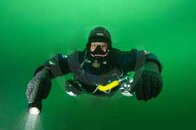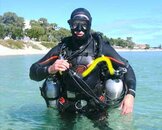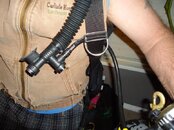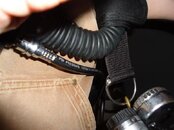I've been struggling with this inflator attachment position issue, especially since I've never dove side-mount so the hands-on practical side (e.g.: how easy it is to run the low pressure inflator hose from 1'rst stage to BCD) is something I can't grasp well.
The issue of hose routing does need to be included in the equation. Top Mounted LPI exist because they are
logically placed in relation to routing an LPI hose from a back-mounted tank/s. Sidemount tanks don't stow on the back (go figure...), they stow along the sides of the torso. Shock... horror.... that means the 1st stage is in a
different location!
Sidemount systems accepted that
reality... and amended the BCD lay-out to
logically place the LPI for efficient hose routing.
Far too many people view the change in sidemount LPI location as being 'overhead environment' specific. I disagree. Yes, locating a hose from the bottom/inside of the wing does offer it more protection. But, it's also the
logical place to locate it, based on cylinder/1st stage positioning.
 Bottom located LPI
Bottom located LPI - showing direct and efficient LPI hose routing to the inflator.
No kinks or bends in the hose.
Hose reinforces LPI location - stiffness keeps it snug, secure and stops it moving around.
 Top Mounted LPI
Top Mounted LPI - showing convoluted and in-direct LPI hose routing to the inflator.
LPI needs to be bent through 180 degrees to match orientation of the inflator.
Hose stiffness tends to push LPI away from the body and/or move it around the chest area.
As an instructor, I've noticed that the biggest learning/comfort hurdle experienced by sidemount trainees
isn't the location of the LPI... it is the task loading of dealing with all those clips, hoses etc. Top mounted LPI cause more of a hose 'tangle' around the torso and left-side d-ring... actively reducing comfort and ease.
I'm not tied to one particular sidemount rig - I've taught courses to students in BP&W conversions, OMS, Hollis SMS50 & SMS100, UTD Z and Razor sidemount rigs. What I've noticed is
far more student comfort when diving a cleanly rigged, efficient and clean rig... which is heavily influenced by intelligent and economical hose routing. Thus, students with top-mounted LPIs struggle more...and have more frustrations... that those who arrive for training with bottom-mounted LPIs.
....the issue of dumping while horizontal, even if needing a small 'roll', they tend to master very quickly...
Add to that.. the issue of cylinder
stability Cylinders hang nice and snug next to the diver when horizontal. They don't move around, swing about or otherwise screw with the divers' stable platform. Not so when vertical... you'll have those cylinders hanging low, bashing your thighs and knees, dragging hoses out of comfortable positions etc etc. Your 'stable platform' now becomes a teetering-tottering pillar of instability. At the end of the dive, that's even worse...especially in Ali tanks... where tank buoyancy is pulling the bottom of the tanks upwards, but your rig is trying to pull them downwards. It's a physical conflict... conflict breeds instability.
If taught, or encouraged, to dive that way... it'll be no wonder that the new 'generation' of recreational sidemount divers won't ever get to experience the real benefits and pleasure of diving that system.
Sidemount
isn't hard, difficult, complex or
'tech', it is just
different. To attain its benefits, you need to adopt a
different approach... new skills, new concepts.
If you previously always played soccer and someone gives you a football... then you'll find it frustrating to kick the football around on the grass. It's different. Pick it up and play with it as it was meant to be used... and you'll find it intuitive, easy and joyful. Different needs different.
Now, as to whether rec. side-mount divers should dive like usual despite a side-mount rig. (e.g.: descent & ascent horizontally, expecting to be able to dump air from the inflator, not a dump valve) as opposed to going up horizontally, that is a little easier to get.
Should the aim to be making sidemount as
similar to backmount, at the expense of performance?
Or should it be a simple acceptance that sidemount is
different and requires
new skills and
procedures?
Yes... we know where this is going... because new "sidemount instructors" are spawning like spring rabbits and many of those receive exceptionally diluted training... which they further dilute in passing to their students. We cannot expect those individuals to have mastered the principles of horizontal trim, streamlining or an understanding of the finer points of hose management.
The answer? Bastardize the system... throw in some
familiar back-mount features and
lower expectations of what should be taught/achieved in training.
The PADI sidemount course stresses the importance of horizontal trim...and applies standards to that effect. It's the first PADI recreational course to do so. However, those standards (less than 8 months old) are already degraded to a significant proportion. It (the course & standards) worked initially when the vast majority of new PADI sidemount course hailed from a technical diving background. Newer instructors don't... so, thus, don't have the necessary expertise to teach it properly as the standards dictate.
So what's the way the world learns to dive? They dumb it down... lower expectations, accept compromises to veil skill deficits..
1.) Descending & ascending vertically is often encouraged to aid orientation. I read somewhere it may aid equalizing by encouraging mucus to drain. It also lets you slowly fin your way up on ascent, which seems less practical if you're horizontal the whole way.
Situational awareness aids orientation. Enough said...

Horizontal ascent/descent is the 'norm' in technical diving. Don't those dives require more orientation and awareness?
Being horizontal is stated to improve off-gassing efficient (reduced pressure gradient across the body). IMHO, that trumps 'mucus drainage'.

2.) In Bonaire, if I'm coming up aways from shore, I like to look around so a boat doesn't part my hair in a new way. Granted, that whiny 'moped' like racket is helpful for knowing one's around, but I like to look, too. I know you can look up to a point horizontally, but looking up & around sounds awkward.
Do you need to be vertical from the bottom to the surface to check for boats? Or can you ascend horizontally (at least until safety stop?), before having a good look around and finishing your ascent?
I stay horizontal...at all times... until I reach ~1m shallow. Only then do I go vertical to breach the surface. On that final (5m/1min) ascent, I have plenty of time to scope my situational awareness and ensure no issues when reaching the surface. I can scoot through a helicopter turn to clock a 360 degree view. I can see above, below and around me. Doing so doesn't impact my buoyancy or ascent speed.
I'm pedantic with students about dropping into vertical trim. Really,... I'm going to buy a spanking switch... The reason is... it promotes the
tendency or habitual reaction to drop
out of horizontal trim whenever task-loaded or stressed. If that's what you do regularly, it's what you'll do when otherwise max'd out. I dive wrecks... so that
tendency, if uncorrected, will lead to frequent silt-disturbances. On a coral reef, it leads to ecological damage.
You'd be surprised how inevitable that reaction is. Take a recreational diver, throw them a curve ball... and count the seconds before they become a bottom-churning rototiller.
3.) I would think companies make products for the mainstream customer, not the people they think those customers ought to be. Will a top-positioned air exhausting system better serve a large number of the type of divers who buy these things for ocean diving?
Companies make products that'll sell. They'll sell because they can be marketed. These 'Open Water' Sidemount rigs are a great example of that marketing. Marketing that plays upon the 'dark side' myth... making tech/cave approach to be something alien, complex and 'advanced' (whatever...).
Recreational divers aren't recognizing 'top-mounted LPI' as being preferable... they're being told that by a marketing department. What they're being told is very skewed, drawing upon carefully chosen attributes... whilst ignoring the rest of the reasons. They know a proportion of customers will always choose the 'quick-fix' option.... so they produce a scuba equivalent of "5 Minute Abs"... "
no need to improve skill, no need to adopt new approaches...accept bad performance.... but call yourself a "sidemount diver" and get groovy in the trendy gear...because we've dumbed it down..."
With all the threads over time criticizing the skill capability of many divers & the lax requirements of modern training, seems to me if the gear adds requirements (e.g.: a partial roll to vent air, or being horizontal), it could be more awkward for many who will use it.
The answer to low "skill capacity" is to improve skill. What you're suggesting is to "remove the need to have skill". The most comprehensive way to do that is to give up scuba entirely, and just visit an aquarium..
Of course, the agencies
love the "remove the need for skill" solution, don't they?

As do the spring rabbit instructors... who don't have the skills themselves...








